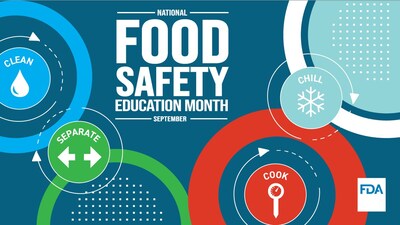Learn More About Food Safety This National Food Safety Education Month

SILVER SPRING, Md., Sept. 5, 2024 /PRNewswire/ — September is National Food Safety Education Month. The U.S. Food and Drug Administration (FDA) focuses on the importance of food safety, especially for those more vulnerable to foodborne illnesses, commonly known as food poisoning. By following four simple steps—clean, separate, cook, and chill—you can lower the risk of getting sick. Discover more about the dangers of foodborne illnesses, and how to protect those at higher risk of getting sick below.
Groups at High-Risk of Foodborne Illness
Every year, 1 in 6 Americans gets sick from foodborne illnesses. Foodborne illnesses also result in an estimated 128,000 hospitalizations and 3,000 deaths yearly. Some groups of people are at greater risk of getting a foodborne illness or experiencing one for longer, require hospitalization, or even die. These groups include:
- Children younger than 5 years
- Older adults (especially people 65 years and older)
- Pregnant people and their unborn children
- People with cancer, diabetes, HIV/AIDS, organ transplants, and autoimmune diseases
Foods Associated with Higher Risk for Foodborne Illness
If you or your loved ones are at a high-risk of foodborne illness, reduce the risk by knowing which foods are associated with higher risk:
- Raw or undercooked meat or poultry.
- Hot dogs, luncheon meats, other deli-style meats, and poultry products – unless they’re reheated until steaming hot.
- Unwashed fresh vegetables, including lettuce/salads.
- Unpasteurized (raw) milk and products made with raw milk, like yogurt and cheese.
- Soft cheeses made from unpasteurized milk, such as Feta, Brie, Camembert, blue-veined, and Mexican-style cheeses (such as Queso Fresco, Panela, Asadero, and Queso Blanco).
- Raw fish products, such as ceviche and seafood mixes, as well as products containing uncooked or undercooked seafood, including blanched or seared shrimp and crab, and refrigerated smoked seafood.
- Raw shellfish (like oysters, clams, mussels, and scallops) and their juices.
- Raw or undercooked eggs or foods containing raw or undercooked eggs (like dough and batter), as well as certain homemade salad dressings (like Caesar dressing).
Review the FDA’s complete list of higher risk foods.
Symptoms of Foodborne Illnesses
If you eat contaminated food, symptoms of foodborne illness appear 12 to 72 hours later, but they may occur between 30 minutes and 4 weeks later. Symptoms can include:
- Nausea, vomiting, diarrhea (may be bloody), and abdominal pain.
- Fever, headache, and body ache
You should contact your physician or health care provider as soon as possible if you suspect you may have a foodborne illness.
To keep you and your family safer from food poisoning, follow these four simple steps:
- Clean: Wash hands and surfaces often.
- Separate: Separate raw meats from other foods.
- Cook: Cook to the right temperature.
- Chill: Refrigerate foods promptly.
To learn more about each safe food handling step, visit:
https://www.fda.gov/food/buy-store-serve-safe-food/safe-food-handling
For more information for people at high-risk for foodborne illness, visit: https://www.fda.gov/food/consumers/people-risk-foodborne-illness
For more information about National Food Safety Education Month, visit:
https://www.fda.gov/food/consumers/food-safety-education-month
Contact: Media: 1-301-796-4540 Consumers: 1-888-SAFEFOOD (toll-free)
![]() View original content to download multimedia:https://www.prnewswire.com/news-releases/learn-more-about-food-safety-this-national-food-safety-education-month-302233449.html
View original content to download multimedia:https://www.prnewswire.com/news-releases/learn-more-about-food-safety-this-national-food-safety-education-month-302233449.html
SOURCE U.S. Food and Drug Administration



